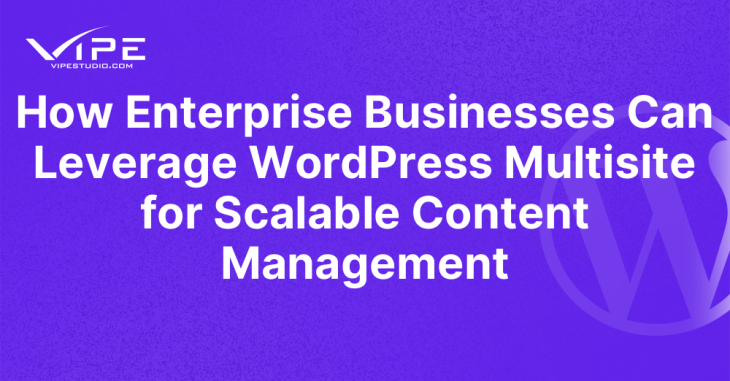How Enterprise Businesses Can Leverage WordPress Multisite for Scalable Content Management

READING TIME: MIN
Managing content across multiple websites can be a daunting challenge for enterprises with global operations, multiple brands, or large-scale projects. WordPress Multisite offers a scalable and efficient solution, allowing businesses to control multiple sites from a single dashboard while maintaining flexibility and security.
In this article, we explore how enterprises can use WordPress Multisite to streamline content management, improve collaboration, and enhance digital experiences.
Understanding WordPress Multisite: What Makes It Ideal for Enterprises?
WordPress Multisite is a built-in feature of WordPress that enables the creation of a network of websites under a single WordPress installation. Instead of managing multiple separate instances, enterprises can consolidate website administration, user roles, and content distribution.

Key benefits of WordPress Multisite for enterprises include:
- Centralized Management: Manage multiple websites from a single WordPress dashboard.
- Consistent Branding: Maintain uniform design elements across all sites.
- Efficient User Roles and Permissions: Assign different access levels for administrators, editors, and contributors.
- Scalability: Easily launch new websites under the same network.
- Cost-Effective Maintenance: Reduce hosting, security, and development costs by managing updates and plugins centrally.
Use Cases: How Large Enterprises Benefit from WordPress Multisite
Many global corporations, universities, media organizations, and government institutions use WordPress Multisite to manage diverse content needs. Common enterprise use cases include:
- International Websites: Businesses with multilingual or region-specific sites can operate them under a single network while customizing content for each audience.
- Franchise and Multi-Brand Management: Companies with multiple brands can maintain individual websites while ensuring design and content consistency.
- Corporate Intranets: Enterprises can create internal communication hubs for different departments or subsidiaries.
- Educational Institutions: Universities and schools can provide faculty, departments, and students with dedicated websites.
- Media and Publishing Networks: News organizations can run multiple publications efficiently under one infrastructure.
Configuring WordPress Multisite for Enterprise-Level Performance
Setting up WordPress Multisite for large-scale businesses requires careful planning and configuration to ensure stability and security. Important setup steps include:

- Choosing the Right Hosting Solution: Use managed WordPress hosting providers like Kinsta, WP Engine, or cloud-based services such as AWS for performance optimization.
- Deciding Between Subdomains and Subdirectories: Enterprises must choose between “subsite.example.com” (subdomains) or “example.com/subsite” (subdirectories) based on business needs.
- Implementing Custom User Roles: Assign different permissions for site administrators, content managers, and contributors to streamline operations.
- Standardizing Plugins and Themes: Install shared themes and plugins across all subsites to maintain consistency while allowing specific customization where necessary.
- Enabling Single Sign-On (SSO): Implement SSO solutions to simplify access management for large teams.
Security and Compliance Considerations for Multisite Networks
Since all websites under WordPress Multisite share the same core files, security is a top priority. Enterprises should implement:
- Regular Security Audits: Monitor vulnerabilities and apply security patches proactively.
- Role-Based Access Control: Restrict administrative access to prevent unauthorized modifications.
- SSL Certificates: Encrypt all websites under the network to protect user data.
- Compliance Measures: Ensure GDPR, HIPAA, or CCPA compliance depending on the industry.
Optimizing WordPress Multisite for SEO and Performance
Enterprise websites must ensure optimal performance and search visibility. To enhance SEO and loading speed:
- Use a Content Delivery Network (CDN): Distribute content globally to reduce load times.
- Optimize Images and Caching: Implement lazy loading and caching strategies to improve performance.
- Manage SEO Separately for Each Subsite: Use SEO plugins like Yoast SEO to customize metadata, sitemaps, and keyword strategies for individual sites.
- Implement Structured Data: Use schema markup to improve search engine indexing.
Scaling Enterprise Operations with WordPress Multisite
WordPress Multisite is an excellent solution for enterprises looking to expand their digital footprint. Whether launching new brands, localizing content, or building internal platforms, this setup ensures efficiency, scalability, and cost-effectiveness.

At Vipe Studio, we specialize in setting up and optimizing WordPress Multisite networks for enterprises. Our team ensures a seamless implementation, from hosting and security to performance and SEO.
If you’re considering WordPress Multisite for your business, contact Vipe Studio today for a tailored solution.
Final Thoughts: Future-Proofing Your Enterprise Website with Multisite
WordPress Multisite is a powerful tool for enterprises that need to manage multiple websites efficiently. With proper setup, security, and optimization strategies, businesses can leverage this solution to enhance digital operations, improve collaboration, and scale effortlessly.

For enterprises ready to embrace the full potential of WordPress Multisite, investing in expert development and support will ensure long-term success.

